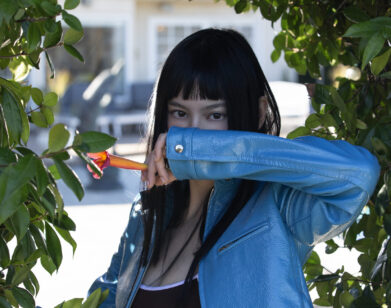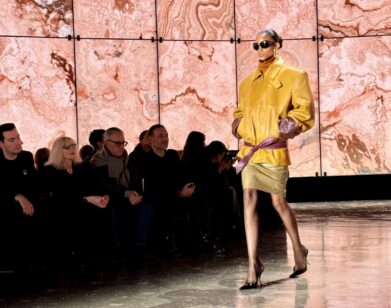Robin Givhan

ROBIN GIVHAN: Special Correspondent, Style and Culture, Newsweek and The Daily Beast. HOME BASE: Washington, D.C. PROVENANCE: Detroit, Michigan. PAST: Fashion editor at The Washington Post from 1995 to 2010, with a brief sojourn as an editor at Vogue; in 2006, became the first fashion writer to win a Pulitzer Prize for criticism. FIRST BEAT: Covering nightlife and the rise of techno for the Detroit Free Press. FIRST COLLECTIONS: Ready-to-wear, Paris. “I remember collapsing on my bed in my hotel room, facedown and weeping hysterically, when the hotel chambermaid walked in. I remember realizing there was someone in the room, and then looking up and seeing this poor woman sort of slowly backing out and quietly shutting the door.”
STEPHEN MOOALLEM: Even though you write about fashion and are known for your writing and thinking about fashion, it sometimes seems like fashion, at least in and of itself, isn’t necessarily the subject—that it’s more of a lens. How do you define the job for yourself?
ROBIN GIVHAN: I think of myself as the eyes and ears and voice of the reader. Because I’ve predominantly worked for general-interest publications, I always feel like I am not there to speak to the fashion insider. In many ways, I’m there to talk to those people who I think are often sort of estranged from the industry—and by that, I mean those who feel that somehow fashion isn’t for them, or that it’s not speaking to them, or that it’s completely disconnected from the way they live their lives. I would argue vociferously that that’s not true, that fashion is very much connected to people’s lives. But I always feel like my first responsibility—and my only responsibility—is to my reader, and that reader is not necessarily someone who is happily spending $500 or $700 on a pair of shoes.
MOOALLEM: So then how do you define fashion?
GIVHAN: I’ve always summed up my definition of fashion as the way that people present themselves on the public stage. That, to me, gives you the sweep of fashion—the immediate recognition that it’s not just about the high-end, and that it’s not necessarily about fast fashion or mass-market fashion, either. It’s about all of those things. But I think it also allows you to talk about issues like status and gender and power and self-esteem, and everything that goes into how we package ourselves. And I say “the public stage,” because how we dress ourselves in private is a completely other issue. But particularly when I moved to Washington, D.C., I became really fascinated by the role that fashion played here, because people here are so conscious of how they are perceived publicly. It’s like this third rail in Washington. For me, one of the most interesting columns to write was about Dick Cheney when he represented the U.S. at a commemorative ceremony at Auschwitz.
MOOALLEM: The green parka.
GIVHAN: The green parka. There was this wonderful wide-angle photograph where you could see all of the world leaders sitting there, and just aesthetically, he stood out. But what I was fascinated by was that almost every aspect of the ceremony was all about symbolism. They had these flashing lights and they had the sirens and the entire ceremony was just weighted with symbolism. And the idea that someone representing the U.S. would dress himself in a way that seemed so tenured, given the occasion, I thought, spoke volumes. You know, this was someone who had recently just come off of a second inauguration—another occasion that, in Washington, is just really all about the symbolism—and for that, he had chosen to dress in a very different way.
MOOALLEM: What impact do you think the instantaneous nature of things has had on how people talk about fashion? The images from shows begin popping up and the commenting very often starts before the final look has even come down the runway.
GIVHAN: I think that if you want instantaneousness, then live-stream the show and people can absorb it themselves and make of it what they want. But I don’t think that there’s anyone—myself included—who can come up with something thoughtful, that provides some context, two seconds after they’ve seen something. I also think it changes the experience. I have a rule that I don’t review shows from photographs or from video. I certainly might go back and look at photographs and look at video to remind myself of something, or for personal information. But I never review from that. And if I go to a showroom and look at a collection that way, I say that I saw it in the showroom, because it’s still a different experience than seeing the show. I’m sort of baffled when I look around and see people at a show, and they’re basically not actually seeing the clothes on the runway—they’re seeing the clothes on a screen on their iPad because they’re recording it. Okay, I get it: You need to upload that while people are still applauding the designer on the runway. But you’re also not seeing the clothes as they were meant to be seen.
MOOALLEM: So how do you negotiate the fact that by the time your piece is out there, the clothes have already been seen and discussed?
GIVHAN: I like to think that the reason that someone is going to one of my stories is because they want my view of the collection—the context that I put it in, and the way that I might connect it to the broader culture or help them understand what the designer was attempting or where they were coming from. I like to think that even if a blog might have 20 images from a collection up there immediately, I can still bring an added value to a story that appears the next morning. There is also the opportunity to go back to the designer and ask them a question, or if there is some piece of music or some allusion in the collection, to go back and find out what that music was or learn something more about that reference, so that you’re not just writing captions for pictures. I actually think I kind of suck at describing the clothes. I mean, how many different ways can you say “dress”?
MOOALLEM: You’ve worked at newspapers and online and then you also worked briefly at Vogue. Is there a difference in terms of how fashion magazines treat fashion? Do you see one?
GIVHAN: Well, the difference, at least in terms of going from a newspaper to Vogue, was that I had the realization that any dedicated fashion publication is part of the fashion industry, and part of its mandate is to celebrate that industry. And for a newspaper—and certainly one like the Post or a magazine like Newsweek—it’s just about the story. I don’t mean to suggest that a fashion magazine is not being truthful with its readers, but I just think that a fashion magazine puts the best foot forward for the industry and is less likely to deliver a kind of tough love at times when the industry may have lost its footing. I do worry that consumers have gotten so cynical and things have gotten so murky . . . I don’t want to say that they don’t believe that any coverage is objective, but I think it’s becoming harder to convince them. It’s one of the reasons why bloggers became so popular—because there was a sense that you were getting this kind of outsider perspective. But that’s less the case now because the more powerful certain bloggers have become, the more they’ve been embraced by the insiders. That’s a problem, though, with media in many categories. It’s certainly an issue with political reporting, where there’s always a sense that you’re in the can for somebody.
MOOALLEM: So is there anything that you’d like to see more of in fashion?
GIVHAN: It would probably be gratifying to a lot of customers and a lot of casual observers of the business if they had a sense that the industry as a whole really recognized the impact that it has on our culture. In many ways, the thinking that goes into a lot of the creative decisions and hiring decisions hasn’t really caught up with how much of an impact the business has on the culture. And when I say that, I’m thinking about the magazines, the runway shows, when people are making decisions about who is going on the cover, or of how women are depicted, and those kinds of things. Not to get at all up on a soapbox, but there have been so many times when people have essentially said that a decision that was made was purely aesthetic, and that no offense was meant, or no insult was meant, or “Oh, you’re taking it the wrong way,” or “You’re being overly sensitive.” And to me that is a little parochial, in the sense that you’re thinking that you’re still talking to this little insiders’ club, and what you keep forgetting is that fashion is no longer just this insiders’ club. People who were not invited are also looking at what you’re doing, and the stage is just so much bigger. I don’t think that the business—and its sense of responsibility—has caught up with that.
For more on The Observers, click here.






